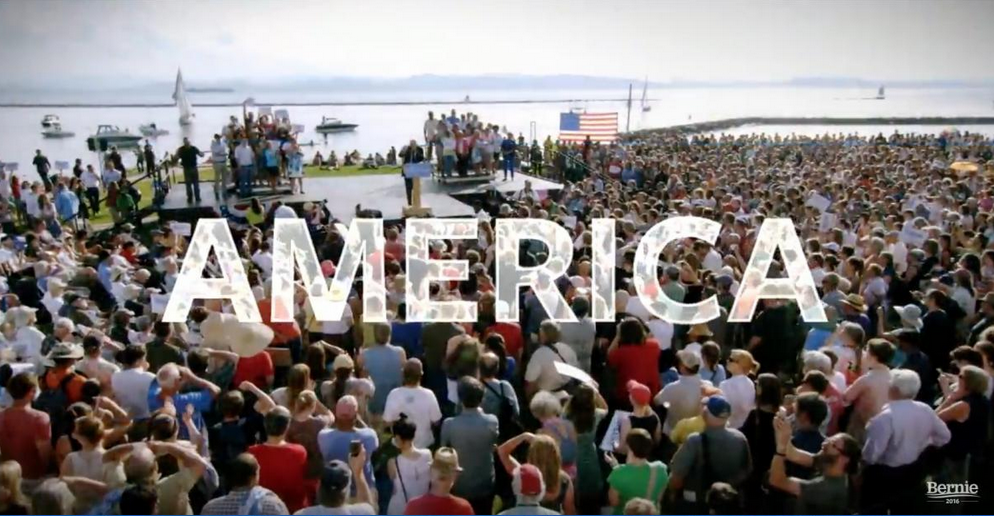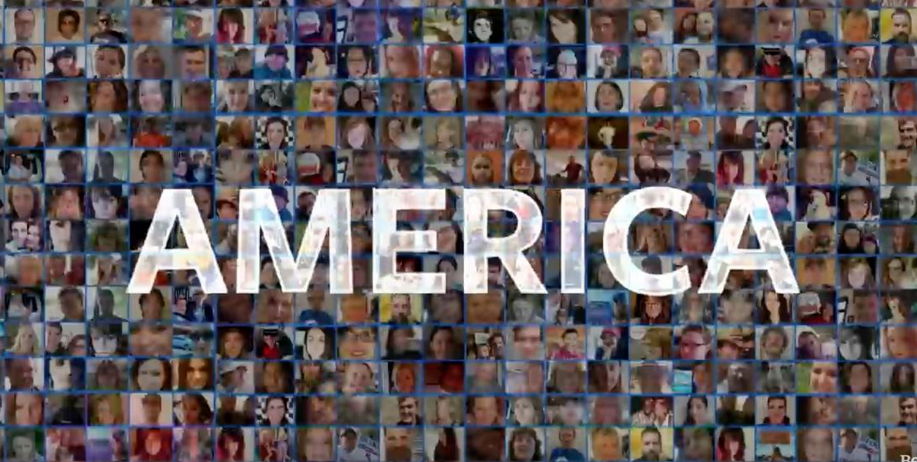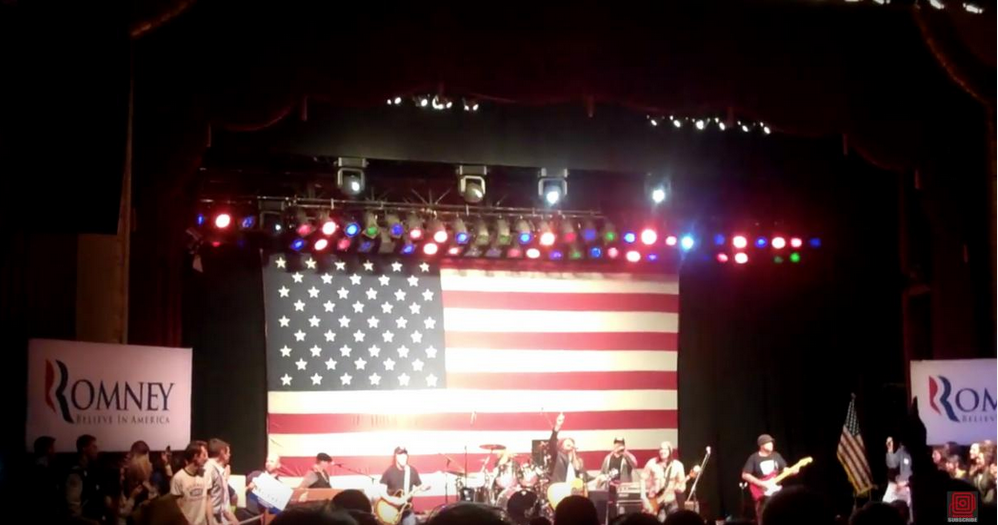August 8, 2016
There is perhaps no phrase that defines the 2016 election cycle better than a return of populism. In the US, populism (broadly defined as appeal to “the people” against established powers, social structures, and hegemonic ideologies and values) bubbled to the surface in the wake of the so-called Great Recession (2007–09). The despair, fear, and frustration of citizens fomented competing populist political ideologies and brought these conflicts into the fiery cauldron of the 2016 campaign. With foreclosure, unemployment, debt, and declining prospects an existential reality, populist ideas from both the left and the right gained traction. These ideas pitted progressive populism against conservative populism in a uniquely 21st-century context of mass media and pop culture. Music from the 2008 and 2012 campaign cycles shows populist campaigning in an early form, which morphs into the pop music bombardment that characterizes the 2016 campaigns.
Popular music participates in the essential functions of democracy, performing and pedagogizing the electorate (Bhabha, 1990), all while inventing “the people” (Morgan, 1988). For Homi Bhabha, democracy plays with time, simultaneously moving the people forward into new identities as modern citizens and backwards into roles that have constituted the identity of the nation in the past. In Edward Morgan’s lengthy analysis of democracy in the UK and the US, he artfully points out that appeals to the people always intend to create a category that is not existential. As it is seen in campaigns where politicians of different ideological leanings all claim to represent “the people,” the construct of “the people” must constantly be re-created through rhetoric, influence, media, and groups of individuals choosing to respond to the call for identification and participation. Popular music on the campaign trail participates in all three of these functions: pedagogizing the people into new identities, performing a time-honored past, and inventing a version of “the people” that includes the audience.
One obvious example is Bernie Sanders’ use of Simon and Garfunkel’s “America” in a television ad released shortly before the Iowa caucuses. The song harkens back to the 1960s, an era characterized as both “revolutionary” and as a period whose agenda remains unfinished (Mosner, 2003). In using the song in the context of the ad, Sanders’ campaign highlights rural America’s rustic glory, firmly rooted in a purified past. The song also participates in pedagogizing by highlighting what modern (meaning “young”) citizens should know about the past, particularly what elements should be transposed into the present and paired with modern sensibilities, like Sanders’ socialist stance, free university tuition, and a valorization of American manufacturing. Finally, Sanders-through-Simon and Garfunkel’s “America” attempts to define ‘the people’ who Sanders’ campaign is focused on helping—Baby Boomers who are concerned about retirement and hip, well-educated younger voters who fret about the very possibility of the American Dream.[i]


Listening to the music of democracy is as essential to understanding it as reading its histories. Popular music, through its familiarity and flexibility, is capable of embodying both the partisan and the nation. It temporarily resolves contradictions in the unstable formations between hegemonic and marginal groups and creates an affect that is both timeless and modern by constructing and narrating a mythical past and utopian future. Analyses of the political efficacy of music culture are acts of self-realization. They inform us of our own relationship to music and make less opaque the effects of music on our political senses. This analysis must also be included in democratic histories. Philosopher Jacques Attali states that, in modernity, music is the monologue of power, the constant annunciation of industrial capital and the culture industry (1985, 9). Listening to the forms and formations of political music in 2012 tells us the pre-history of the populism that is now pervasive in popular ideology and the 2016 campaign, and allows us to more fully comprehend music’s power and potential. When examined together, 2012 and 2016 campaign music tells us about the relationship between music, populist rhetoric, and power in our current politics.
A complex mass of operations lies at the intersection of campaign-related usage of popular music and populism. These include attempts at creating affective links, the reinforcement of collected identities, the construction of new identities, and the maintenance of a constant contest to re-invent “the people.” At the birth of democracy, historian Edmund Morgan posits, there was a need to create a people—to define national culture, needs, and visions—in such a way that the many could be ruled by the few (1988). David Hume observes that this task is more easily accomplished than it should be, and that it is often accomplished through the manipulation of opinion, and opinion is manipulated by emotion (quoted in Morgan, 1988, 1, 13–15). In these calculations that ripple across crowds of supporters, the airwaves, and the Internet, music is often utilized as a catalyst. A close examination of the campaign music, populist policies and ideologies, and historical links between late nineteenth- and early twenty-first-century populism illuminates the cultural work that politicized popular music does (or attempts to do), situates the race of 2016 into a broader historical context, and raises questions about music’s role in future campaigns.[ii]
Contemporary popular music culture was a key component of the nascent populism of 2012 and is front and center in 2016. Competing populist policies manifested by the Tea Party on the Right and the Occupy movement on the Left paved the road leading up to the 2012 campaign. While both of these umbrella ideologies were contradictory and contained mutually distrustful factions, the breadth of populist politics and their impact on the policies, rhetoric, and cultural expressions of both sides were clearly felt. For the Romney campaign, the nativism, isolationism, rugged individualism, jingoistic nationalism, and valorization of white, working class-culture of Tea Party ideology manifested itself in Romney’s choice of Kid Rock’s “Born Free” as a campaign theme song. While the song was effective as a campaign mechanism, Romney and Kid Rock made for strange bedfellows, and the musician’s genre-jumping career was an odd shadow to critiques of Romney’s political opportunism. The every-voice-should-be-heard ideology of the Occupy movement was partially echoed in the Obama campaign’s mixtape, which also repeated some of the shortfalls of the Occupy movement.

Country music was a key ground on which Romney labored to convince a nervous, vulnerable middle class and an angry working class of his conservatism, patriotism, and dedication. For Romney, Kid Rock’s “Born Free” mirrored major gaps in his campaign persona and communicated to his supporters on the level of ideology and affect. However, Kid Rock’s musical travels from gangsta rapper to nu metal icon to red meat Americana songster and country rock singer also matched Romney’s political maneuvers from moderate Republican governor who supported choice, universal healthcare, and gun control to Tea Party and 2nd Amendment-friendly candidate.
Contemporary popular music was also the plane on which Obama met a divided and disheartened electorate and appealed for another four years to finish the project of repair, restoration, recovery, and redemption. The Obama campaign largely abandoned the soundtrack of 2008, marked by Stevie Wonder’s “Signed, Sealed, Delivered,” John Legend and will.i.am’s “Yes We Can,” and Brooks and Dunn’s “Only in America.” The 27-song 2012 mixtape ran the gamut of radio-appropriate pop, containing healthy doses of Nashville country, classic soul, adult contemporary, and inspirational songs. Conspicuously missing were hip hop and electronic music, as well as tracks by Latin artists (save for Ricky Martin, who is well known among mainstream Anglo audiences) and rock artists long associated with Democratic campaigns.
2012 also signaled a new era in the political process, which 2016 continued and expanded. With the vast amounts of money spent on the creation of national campaign networks that understand and exploit locality, it is a distinct possibility that, in the wake of the Supreme Court’s “Citizens United”[iii] decision, a single suite of political issues may never again be accompanied by singular musical representation. With the growth of Super PACs and available information to finely target advertising, multiple ways to exploit social media, and the proliferation of news and commentary outlets, campaigns will become octopi, with multiple tentacles meant to grasp specific audiences through locally relevant or single-issue policies accompanied by multiple works of music. 2012 may have seen a final dramatic conjoining of populist policy and musical culture—a high modern attempt at crafting a singular musical-political nationalism before postmodern campaigning embraces the fragmentation of the electorate and gives up on the project of creating a singular, unified “the people.” Populism will no doubt live on in a postmodern guise that has yet to be revealed, but there is little doubt that it will be accompanied by the siren song of popular music. As we can see from a simple search in Trax on the Trail’s database, the uses of popular music in this cycle alone are extremely varied and will likely continue to be in the future.
Listening back to the Obama mixtape from 2012 with 2016’s ears, I detect a hint of the surgical execution of politics that seeps from the Clinton campaign. While political campaigns are all games of calculation, successful campaigns are able to play on spontaneity, in the guise of listening and allowing voices and narratives from the periphery to proliferate through the PA. While Obama’s oratory was able to sway voters, his musical selections from 2012 hinted at forgetting the youth, particularly urban, educated, youth of color, in favor of policies aimed at Main Street, the suburbs, Baby Boomers, and maintaining an economic system that is making enemies, particularly among young voters who came of age in the long shadow of the recession. This critical silencing came to fruition with Hillary Clinton, who struggles to connect culturally and politically with young, well-educated voters whose support will continue to be critical in a closely divided country. Many left-leaning voters identify with the platform of Bernie Sanders, who is widely perceived to be more the champion of the youth and progressives than Clinton. The politics of inclusion demand more than (musical) tokenism and may punish erasure.
In the current electoral cycle we can hear the campaigns working with popular music to accomplish a number of populist projections. As an accompaniment to Donald Trump’s nativist, protectionist, pugnacious rhetoric, his campaign music is both incredibly mundane—featuring an amalgamation of classic rock, Broadway hits, and the famous aria “Nessun Dorma” from Puccini’s Turandot—and plays on repeat at high decibels. His deployment of popular music, especially music that is ultimately common and in heavy rotation on the radio, in background soundtracks, and advertising, is both familiar and numbing, creating a bond between himself and his base of frustrated and disaffected conservatives who feel alienated from government and troubled by the direction they perceive the country to be moving in. His populist policies and ideologies are framed by the sounds of an American golden age of the late 1970s and 1980s, playing upon nostalgia-born affect.
The Clinton campaign uses popular music to its advantage as well. In particular, Clinton has embraced the much-maligned “woman card” since clinching the nomination. While on the trail, she released a 30-track all-female mixtape for women’s history month which included tracks by chart-topping artists such as Katy Perry, Beyoncé, Sia, Shania Twain, and Lady Gaga, as well as the tune “The Schuyler Sisters” from the Broadway smash Hamilton.[iv] Clinton’s playlists frequently target younger listeners by featuring contemporary artists who are household names or who are in rotation with younger listeners (although her recent campaign stops featured, of all things, music by John Phillip Sousa). She has generally abandoned her playlist from 2008, which included Celine Dion, Tom Petty, and Aretha Franklin, for a playlist that is much more youth and young adult pop radio-centered. Clinton’s version of musical populism focuses on the tastes of youth and early adulthood, perhaps in a nod to the young people who powered the Occupy movement, Black Lives Matter, and the Bernie Sanders campaign.
It is also worth noting an ironic switch that has occurred in the 2016 campaigns. With the successful insurgent candidacy of Donald Trump, there is increasing unease and wrangling about the GOP, particularly who and what it represents. The coalition between religious and social conservatives, Tea Party, libertarians, isolationists, imperialists, small government, Second Amendment hawks, anti-tax activists, and fiscal conservatives is fraying. More than playing identity politics, as Romney did, the GOP needs to play at the politics of coalition and inclusion. Perhaps the GOP should re-examine the politics of the mixtape that goes beyond Trump’s classic rock and Broadway-centered sounds. On the other hand, Hillary Clinton now needs to connect with young voters and working-class white men, who see no political or cultural connection to her and feel no enthusiasm for her. Clinton’s campaign needs to reach out at the level of cultural resonance and similitude that Romney attempted in 2012. Perhaps the Clinton campaign needs to find its theme not in a mixtape, but in a strong statement of solidarity with solution-based, young, anxious voters who are tired of identity politics that perform erasure and neglect intersectional and holistic solutions. The Clinton campaign needs a strong, distinct anthem through which to perform unification. But more than these, her campaign needs to do a better job of listening.
– Justin Patch
*A full version of this essay will be published in American Music 34, no. 3 (2016).
Bibliography
Attali, Jacques. Noise: The Political Economy of Music. Manchester University Press, 1985.
Bhabha, Homi. “DissemiNation: Time, Narrative, and the Margins of the Modern Nation.” In Nation and Narration, edited by Homi Bhabha, 291–322. New York: Routledge, 1990.
Morgan, Edmund S. Inventing the People: The Rise of Popular Sovereignty in England and America. New York: Norton, 1988.
Mosner, Richard.
“Was it the End of Just a Beginning?: American Storytelling and the History of
the Sixties.” In The World
The 60s Made, edited by Van Gosse and Richard Mosner,
37–51. Philadelphia: Temple University Press, 2003.
[i] See also Paul Christiansen’s “America” ad article for Trax.
[ii] Here I am referring to populism as a formal political movement, rather than an idea, ideology, or practice, and specifically the organizing work done in the Mid-West, South and Southwest during the late 19th century. These agitations gave rise to the People’s Party, whose platform went on to influence Teddy Roosevelt, Franklin Delano Roosevelt’s New Deal, among others. Despite the party’s demise after a disastrous 1886 convention, many of its ideas were taken up in the early 20th century and the idea of populist wings of either major party began its journey into what we are now seeing. Populists’ frustrations with the end of the frontier, predatory lending, and cultural devaluation are echoed in popular anger over housing, the cost of education, and the lingering culture wars.
[iii] In the 2010 US Supreme Court ruling of Citizens United v. The Federal Election Commission, the court ruled to lift spending caps on private organizations, allowing them to contribute unlimited amounts of money to political influence groups that are formally unaligned with individual campaigns. While individuals and organizations like unions and corporations are limited in the amount of money they may give directly to campaigns, they are free to give unlimited funds to outside groups, known as Super PACs (political action committees). These super PACs can then spend money freely in attempting to influence public opinion and participate in independent campaigning. According to the Center for Responsive Politics, during the 2012 campaign cycle, Super PACs spent over $604 million (https://www.opensecrets.org/outsidespending/summ.php?cycle=2012&chrt=V&type=S). According to the same source, over $755 million has been raised by Super PACs so far in the 2016 election cycle (https://www.opensecrets.org/outsidespending/summ.php?chrt=V&type=S).
[iv] For further reading on Clinton’s engagement with Spotify, see Trax essays by Christianna Barnard and David R. Dewberry and Jonathan Millen.
